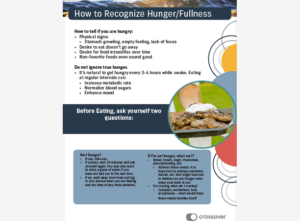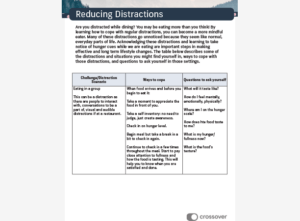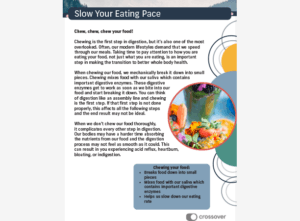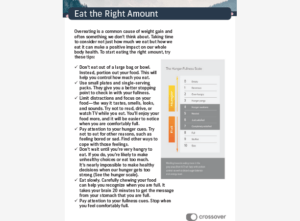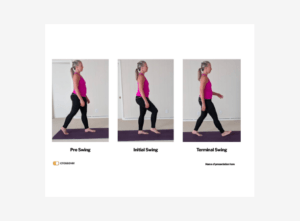
Stress and Resilience
Stress is something we all face and sometimes it can feel hard to manage. On this page you’re going to learn more about how stress affects us and ways to build resilience. When you are resilient, you’re more able to manage what life throws your way.
Learn. Explore the information from our experts about stress.
Practice. Select mindfulness and coping options to reduce stress.
Let us help. Work together with a therapist at any time.
Expert Guidance Along the Way
-
Courtney Ferreira, MS, RD, LDN, CPTHealth CoachCourtney is a Registered Dietitian, NASM-certified personal trainer, and group fitness instructor with several years of experience. She earned her undergraduate and graduate degrees in Delaware before completing her training in Baltimore. In her practice, she employs HAES (Health At Every Size), which holds the belief that every person should be allowed to pursue health and wellness, without judgment.
-
Cong Thanh Nguyen, LAcAcupuncturistCong is a lifelong learner with a passion for martial arts and teaching which lead to his journey of balancing the yin and yang of martial arts and medicine. Already deeply immersed in eastern philosophy and thought, the path of Chinese Medicine was a natural fit.
What is Stress?
Stress is a feeling of pressure or tension that happens when we are faced with some kind of challenge or demand. We can experience it physically, mentally, or both. Stress is a reality in all our lives, and in small doses, it is actually helpful! Without stress, we might not be able to meet deadlines or escape from dangerous situations. However, when the stress is significant and happens for too long, it becomes a problem and can have a negative effect on both our physical and mental health. Learning how to manage our stress levels and response to stress are important skills for maintaining good health.
Stress vs Anxiety
Stress is something we all experience. Anxiety is a mental health concern that affects many people as well. Separating the two can be a challenge. In some ways, they do overlap, but in other ways, they are very different. We described stress above. Things that are associated with anxiety are:
- Frequent worrying
- Imagining worst case scenarios (the “what ifs”)
- Nervousness
- Physical symptoms including increased heart rate, stomach troubles, restlessness, insomnia, and sweating.
Below is a guide to telling the difference between stress and anxiety.

Navigating the Culture of Stress Conversation
Signs of Burnout
When someone is under a lot of stress at work or life in general, and it goes on for a long period of time, something called burnout can happen. Here are some of the signs and symptoms of burnout:
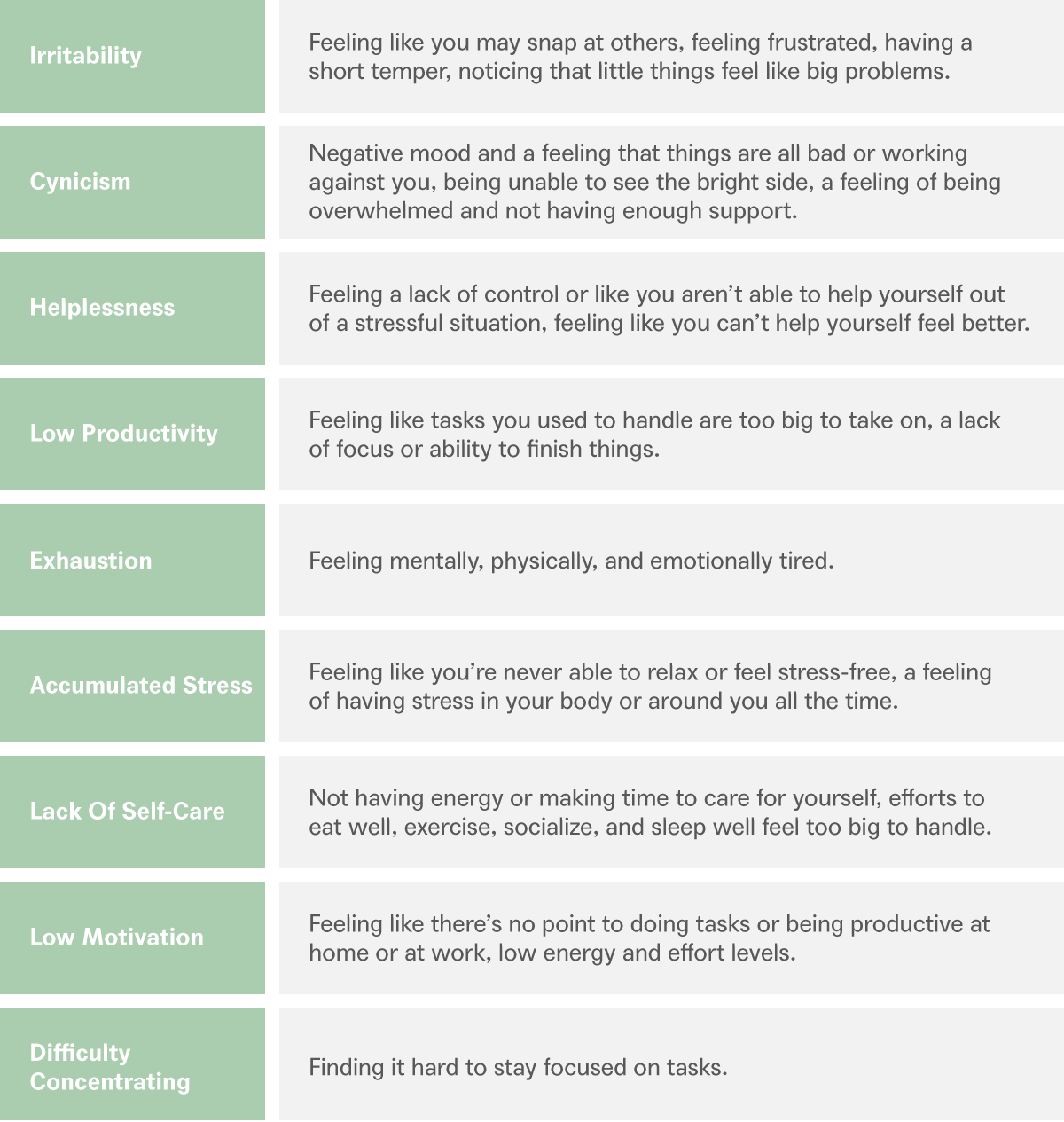
If you feel like you are suffering from burnout, know that there are things you can do to feel better. Sometimes you can reduce stress in your life, and other times you can learn better ways to deal with it. Taking care of yourself might feel overwhelming if you have burnout, but it’s the best way to start. Here are some small steps you can take towards recovering from burnout:
Look for helpful things in your life right now:
- Is there anything you can let go of that may help you feel less overwhelmed and burdened? Maybe there are extra chores, things you do for others, or other tasks you could learn to say “no” to?
- Do you have a support system in place? We all need people we can rely on to help us, encourage us, and keep us motivated. Who do you talk to each week that feels helpful?
- Take a look at your daily and weekly schedule and highlight things that bring on the most stress. Some of them can’t change of course, but are there any that could? Can you add any things that would make you feel fulfilled or balanced?
Look for ways to help yourself—create or remake your self-care plan:
-
 Exercise. How can you move your body every day, even for 10 minutes at a time? Can you talk with your doctor or health coach about helping you make a plan?
Exercise. How can you move your body every day, even for 10 minutes at a time? Can you talk with your doctor or health coach about helping you make a plan? - Meditation. Practice taking a few minutes each day to get quiet and centered.
- Add therapy. Talking with a therapist can help you to identify your needs, improve self-awareness, and feel supported in making positive changes.
- Social time. Can you schedule some time with friends and family? Can you find a hobby you enjoy?
- Take time off. Having something to look forward to can be a great motivator. Knowing an afternoon or a day off is on the schedule can help you stay more balanced and positive.
What is Mindfulness
Simple Mindfulness Starters
Interested in becoming more mindful? There are a lot of resources for you to check out throughout this page. But it doesn’t have to be another task on your list. Mindfulness can be practiced during even the most simple, everyday activities. You can start right now, with these examples:

- Washing the dishes. Yes, even scrubbing bowls can be mindful. Tune into your senses. What is the temperature of the water? What does the dish soap smell like? What does the plate feel like in your hand?
- Vacuuming. How do the lines look on the carpet? What does the carpet feel like beneath your feet? Can you see and feel a certain rhythm in the repeated arm movement?
- Showering. Showers are glorious, aren’t they? So be in the moment and enjoy them! What does the water feel like? What does your shampoo smell like? Where are you holding tension and how does the water help loosen that up?
- Preparing your meal. Chopping veggies? What does the knife feel like in your hand? What smells do you notice? IDo you see a cutting board full of different colors and textures?
- Morning beverage. Are you a coffee or tea drinker? What does the mug feel like in your hand? What does your coffee or tea smell like? As you sip, where do you taste it on your tongue? What does the steam feel like on your face?
Remember, even when you’re trying to be mindful, your mind will wander. When it does, bring your attention back (even for a few minutes) to the tangible things you can see, smell, hear, taste, and feel.
We encourage you to read more about mindfulness as there is so much more to learn and so many benefits. But starting small feels good—it’s free, it’s good for you, and it takes no time away from what you’re already doing. Try one (or more) out!
Mindful Moments
 Welcome to Mindful Moments. In the accompanying videos and handouts, we will be exploring several different exercises designed to calm and ground you. The foundation of these exercises is based on your breath. If you are not already familiar with the technique often referred to as diaphragmatic breathwork, or belly breath, please follow this link to learn more. If you are new to mindfulness, take a moment to check out our introduction to mindfulness here: LINK. We have also included helpful printouts that list the exercises, include videos, and take you step-by-step through each one. Refer to it as you bring breathwork into your own mindfulness practice.
Welcome to Mindful Moments. In the accompanying videos and handouts, we will be exploring several different exercises designed to calm and ground you. The foundation of these exercises is based on your breath. If you are not already familiar with the technique often referred to as diaphragmatic breathwork, or belly breath, please follow this link to learn more. If you are new to mindfulness, take a moment to check out our introduction to mindfulness here: LINK. We have also included helpful printouts that list the exercises, include videos, and take you step-by-step through each one. Refer to it as you bring breathwork into your own mindfulness practice.
We will keep adding techniques to our Mindful Moments section, so check back frequently. And if you’d like more guidance on how to add these grounding exercises into your days, just reach out to your mental health provider for an appointment. We are here to help.
Bumblebee Breathwork
In this first video and handout, we explore a breathing technique called Bumblebee Breathwork.
In addition to using your breath to regulate your nervous system, Bumblebee Breathing adds in a humming sensation and sound that stimulates your vagus nerve. Fun fact: your vagus nerve is the longest nerve in your body and connects to almost every organ! There are many benefits to stimulating your vagus nerve.
Breathing exercises that involve the vagus nerve can be done with a couple of results in mind. There are ways to use this kind of breathing to activate and motivate us. Other times it can be used to soothe and regulate us after we experience a stressful situation.
The really cool thing about this exercise is that the humming sound creates vibrations at the roof of your mouth. These are essentially “massaging” your vagus nerve (which begins at your brain stem) and helping it continue to send soothing signals through your entire nervous system.
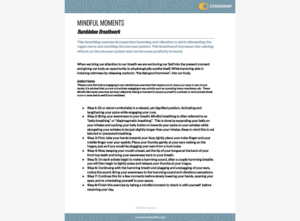 Bumblebee Breathwork
Bumblebee Breathwork
Vagus Nerve Stimulation
There is more than one way to stimulate your vagus nerve. This exercise utilizes massage and pressure points to calm your mind and body. Because the vagus nerve is the hub for information that gets communicated throughout your nervous system, when it is stimulated, it helps our body respond to stress.
These simple exercises send soothing signals throughout our nervous system and organs to regulate and increase overall wellbeing.
Butterfly Hug
In this next video and handout, we explore a tapping technique called the Butterfly Hug.
This exercise is used to decrease anxiety and lower your heart rate with bilateral stimulation. It also mimics a hug-like posture which is comforting and signals to your body that you are safe. Have you ever noticed when someone is cold, upset, or uncomfortable that they may cross their arms over their chest and hold on tight? This is the body’s natural instinct—to provide comfort and security in an attempt to regulate the nervous system.
This mindfulness exercise also uses breathwork to help you feel grounded in the present moment.
Along with breathing and the hug position, the tapping releases energy blockages in the nervous system. This is known as bilateral stimulation, a technique used to stimulate electrical activity between the two spheres of the brain via our neural pathways. Bilateral stimulation keeps us from getting “stuck” on a thought.
Mindful Breathing Exercise
Mantras
Mantras are words or phrases that can (and should!) be repeated. Saying them out loud (or vocalizing) can calm your nervous system.
Daily practice: take a deep inhale, exhale fully, then chant/sing the mantra on the exhale. Repeat 3 times.
- OM (OH-m): release stress; calm your mind and emotions
- Shanti (SHAN-tee): restore peace and harmony
- If it feels more natural to you, simply use these words:
- Inhale, say PEACE; exhale, say TO THE WORLD, TO ALL, TO MY FAMILY, etc.
- Inhale, say LET; exhale, say GO
- Inhale, say I AM; exhale, say ENERGETIC, BEAUTIFUL, READY, etc.
Give it a try and see how you feel!
The Realities of Stress and Eating
Do you eat when you’re stressed?
Everyone responds to and manages stress differently. About 40% of people report they eat more when they feel stressed. Around 40% eat less and 20% don’t change their eating during stressful times. Those who tend to eat when stressed often feel that stress-eating is a major health concern. It’s easy to blame it on having no willpower or on a lack of self-control. But considering what happens inside the body during stress, it seems less and less likely that your willpower is to blame. The body’s response to stress triggers the urge to eat. Understanding what happens in your body when you’re stressed can help you manage it.
Stress and appetite
 Stress prompts the ‘fight or flight’ response in your body. When you experience stress, adrenaline (epinephrine) and cortisol (the stress hormone) are released. During the ‘fight or flight’ response, your body looks for sugar in your system in case you need to fight, or flee. In response, stored energy increases the sugar level in your bloodstream. Usually a hormone called insulin helps the sugar enter our cells to be used for fuel. But in stressful situations, your body stops insulin from working. That keeps the sugar levels higher, but it also means you have more insulin in your blood. If you’re stressed for a short time, your hormones will usually go back to normal. But when you’re under constant stress, your hormones stay at a higher level. After a while, this pushback against insulin gets worse. Insulin increases your appetite—and stress makes sugar, salt, and fat more appealing. Unfortunately, stress also decreases the reward signaling in the brain, as well as its sensitivity. All of these factors lead us to eating more of these types of foods than we normally would.
Stress prompts the ‘fight or flight’ response in your body. When you experience stress, adrenaline (epinephrine) and cortisol (the stress hormone) are released. During the ‘fight or flight’ response, your body looks for sugar in your system in case you need to fight, or flee. In response, stored energy increases the sugar level in your bloodstream. Usually a hormone called insulin helps the sugar enter our cells to be used for fuel. But in stressful situations, your body stops insulin from working. That keeps the sugar levels higher, but it also means you have more insulin in your blood. If you’re stressed for a short time, your hormones will usually go back to normal. But when you’re under constant stress, your hormones stay at a higher level. After a while, this pushback against insulin gets worse. Insulin increases your appetite—and stress makes sugar, salt, and fat more appealing. Unfortunately, stress also decreases the reward signaling in the brain, as well as its sensitivity. All of these factors lead us to eating more of these types of foods than we normally would.
What happens to your eating and your body when you have a lot of stress:
Stress makes your body release a hormone called cortisol. Raised levels of cortisol may:
- Make blood sugars harder to control
- Cause weight gain, especially in the abdomen (visceral fat)
- Impact appetite and cravings
- Weaken the immune system
- Impact digestion
- Lead to heart disease
- Lead to fertility issues
The amount of cortisol that is released will be different in your body than in another person. That can help explain why stress makes some people eat more than others. Making yourself feel bad for eating when you are stressed leads to more stress! Food might make you feel better in the moment, but it can leave you feeling tired and guilty about what or how much you ate.
Stress can impact what you want to eat, how much you eat, and how that food is handled in your body. But when you’re stressed, weight gain isn’t just about food. People who are stressed often exercise less, sleep worse, and are more likely to turn to alcohol or other substances for some relief. That’s why it’s important to manage stress in healthy ways.
What to do about stress eating
Stress eating is a reality for many. But when eating becomes the only thing that makes you feel better, it’s a more serious issue. You need more than one tool in your toolbox. Finding new ways to manage both short-term and long-term stress can go a long way in improving your relationship with food and stress. Visit the section on stress on our Be Well website to learn more.
Principles of Mindful Eating
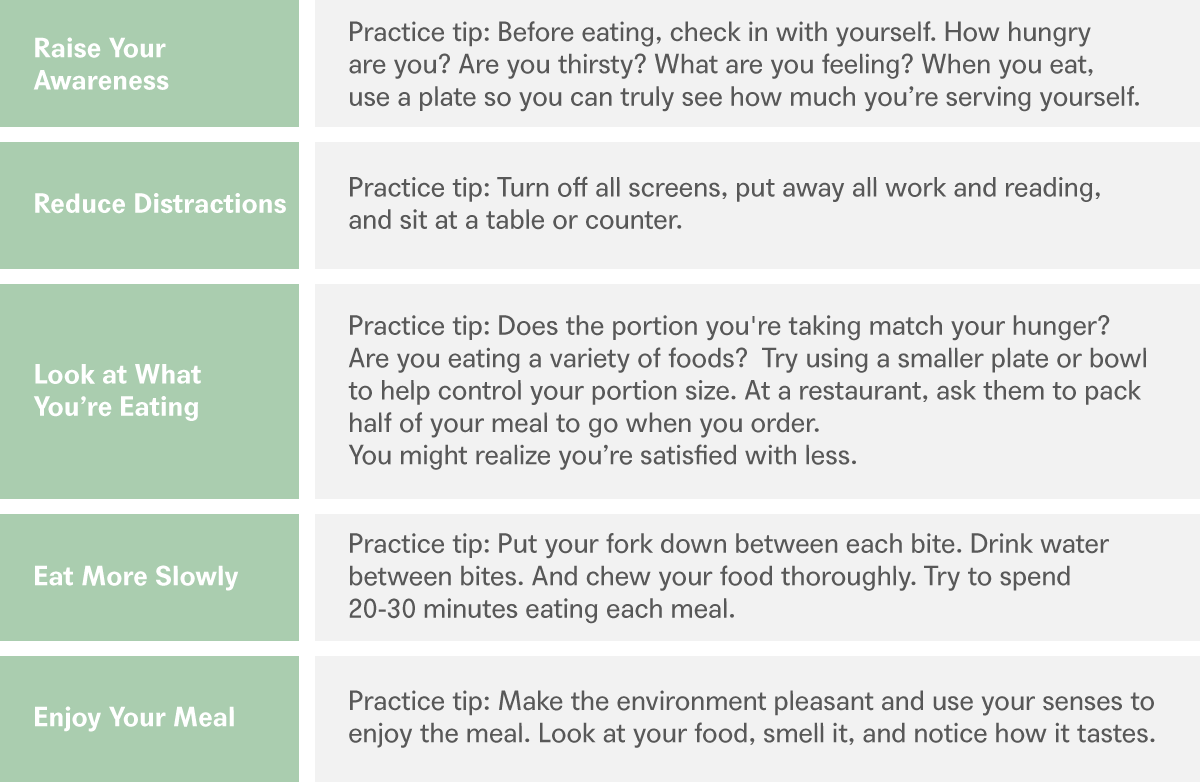
Benefits of Mindful Eating
Enjoying your meal is part of mindful eating. It just means that you’re focusing on your food, rather than on other things. Have you ever eaten a meal while watching TV or looking at your phone? Did you even taste your food or think about how satisfying it was?
Mindful eating allows you to slow down and be aware of nourishing your body. It’s also one part of mindfulness as a whole. You can learn more about the benefits of mindfulness here.
Mindful eating offers other benefits, including improvements in:
- Binge eating disorder symptoms
- Emotional eating
- Digestion (When you eat more slowly, you lower your body’s stress levels. That helps connect your mind to your body. You chew your food well and make it easier for your body to digest.)
- Blood sugar control
- Quantity and quality of foods consumed
- Feelings of food guilt and shame
It’s important to note that there is no one way to go about mindful eating. Sometimes mindful eating is more effective when used with other treatments and therapies. Also, you’ll notice weight loss is not mentioned as a benefit. That’s because for some people mindful eating will result in weight loss, and for others, it won’t.
Getting Started with Mindful Eating
The following videos and handouts explain each of the principles of mindful eating. Pick a principle you’d like to try. Remember, you don’t have to do this for every meal or every day to start. Choose a goal that is achievable!
What is Urge Surfing?
Urge surfing is a mindfulness technique. You can use it to experience a craving rather than fight it. Picture a surfer riding a wave. When you go urge surfing, you are riding the waves of a craving. Urge surfing is a way to just feel the feeling and allow it to pass without fighting it or giving in to it. When you fight a craving, it’s easy to end up thinking about it all the time. It’s like trying to stop a waterfall from flowing. When you fail, it can feel exhausting and less confident of your ability to fight it next time. Letting go of that desire to control the craving takes so much less energy! When you just “go with the flow” you ride the wave of the urge, or surf it.

You can also use the power of your mind to step aside and watch the cravings, impulses, and urges pass, like water flowing in a stream. You see it, but you don’t have to control it or do anything but let it pass. This mindfulness approach can give you the confidence you need to overcome cravings in the future as well.
Cravings, like waves, usually:
- Start small,
- Build momentum as they ramp up,
- Hit a peak, and then
- Gradually fall.
And, like a wave, the urge you are feeling WILL pass—you just have to let it.
Through practice, you will learn to experience an urge without acting on it!
Key Points for Urge Surfing
- Practice mindfulness.
- Watch the breath without altering it.
- Notice your thoughts without judging them, feeding them or fighting them.
- Notice the craving experience and how it makes your body feel.
- Focus on one area where the urge is being felt and noticing what is occurring.
- Notice where in your body and how strongly you feel the craving.
- Notice if or how these feelings change with the in-breath and out-breath.
- Repeat the focusing process with each part of the body involved.
- Remain curious about what occurs and notice changes over time.
The key is to know it won’t last forever. It will come and go. You are replacing the fearful wish that the craving will go away with curiosity about your body and feelings. . When you do this, you notice your cravings rise and fall like waves in the ocean.
Urge Surfing Exercise
As you begin to experience an urge for something you have given up, imagine that the urge is a wave in the ocean that will rise, peak, and fall. Urges generally start small before growing in size or strength and then going away. Practicing this mindfulness technique can prepare you to ride these waves without giving in to the urge. Your brain will rewire and that will help make this process easier over time. To practice urge surfing the next time a craving comes up, follow the steps below:
- Sit quietly and comfortably
- Observe your breath without trying to change it
- Notice your thoughts
- Bring your attention back to your breath without judging, feeding, or fighting your thoughts
- Notice where the craving affects your body. Where in your body are you experiencing the craving?
- Bring your attention to an area of the body where you feel the craving and notice what is happening in your body; see if these bodily sensations change as you inhale or exhale.
- Bring your attention to another part of your body where you are feeling the urge and repeat the process.
- Be curious about the urge and how it changes.
You have heard about mindful thinking and eating. Now let’s talk about mindful movement! You move every day, but how can you learn to be mindful in your movements, activities, exercise, or even while relaxing? Bringing your awareness to your body and really being in it, feeling your muscles, joints, and limbs moving through space might be something you haven’t considered. You don’t really notice how your body functions until there is something that limits you. By being more aware, present, and mindful of how you feel when you move, you have an opportunity to appreciate just how miraculous your body is!
Getting Started with Mindful Movement
- Remain as present as possible during everyday activities without going into autopilot.
- Know that learning how to be more aware strengthens your brain.
- Set yourself up for success. If you intend to meditate or exercise, put your yoga mat next to the bed or your running shoes near the front door.
- Set your intention with a mantra or affirmation. Here’s an example:
- During my walk today, I will stay present. I will focus on my stride, deepen my breath, and enjoy all that I see, smell, feel, and hear.
- A mantra or affirmation can even work with something you dislike, like traffic:
-
- “My drive to work will be enjoyable and I will arrive at work on time.”
-
Benefits of Mindful Movement
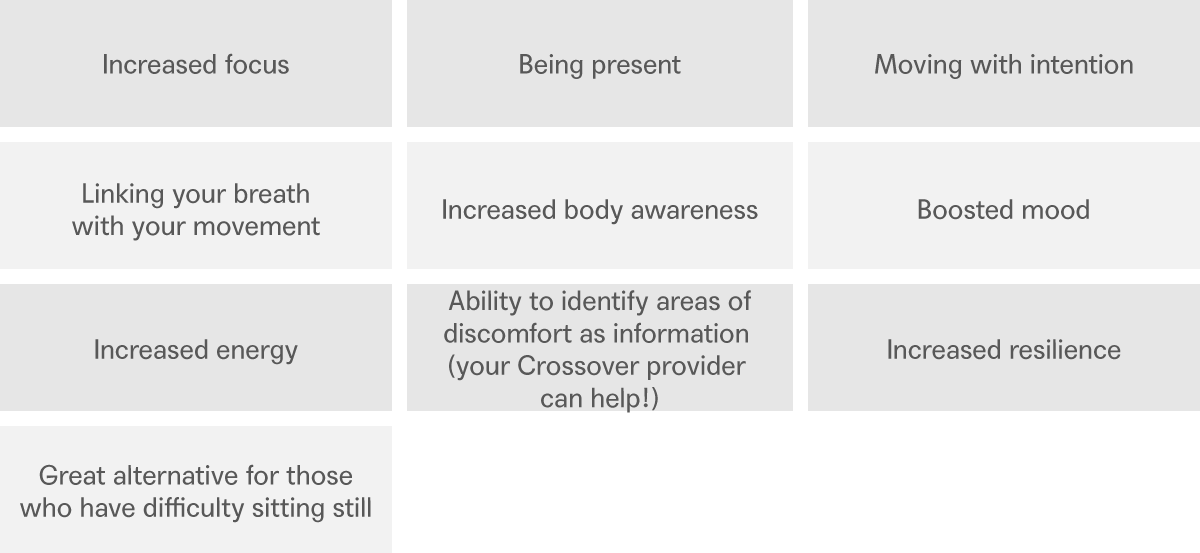
Examples of Mindful Movement
You can bring mindfulness to all of your activities, but let’s use walking as an example.
- Consider taking a few breaths to set your intention (“I am going to listen for birds today, I am going to count my steps, and I will focus on my posture.”)
- Scan your mind—note your mood and your energy level. You can even describe how you feel—enthusiastic or indifferent, irritated or relaxed.
- Now that you have checked in with your mind, take a look at your body. Start by noticing how your body feels—energized or lethargic, strong or sore. Scan your body head to toes and back up:
- Starting at your toes work your way up to your feet, ankles, knees, hips, fingers, hands, wrists, elbows, shoulders, low back, mid back, upper back, neck and head, face, jaw, eyes, and area between your eyes.
- Begin your walk.
- Start by simply observing your motion, make no changes simply observe. What do you notice?
- Are your shoulders relaxed? Are you clenching your teeth? Are you focused on speed or enjoying the movement?
- How are your feet striking the ground? Are you rolling from heel to toe?
- Is your stride comfortable or forced?
- Are you rushing?
- Are you enjoying being outdoors?
- What else do you notice? Are your arms swinging? Is your core tight? Are you slouching or maintaining upright posture?
- What are you thinking about? Is your mind racing? Is it hard to focus on being present?
- Periodically check back in to see how you feel. Notice any limitation or discomfort, note your mood, note your energy level.
- Consider some of these changes or adjustments to your breath, your stride or your posture:
- Focus on upright posture, how your feet strike the ground, increasing your stride length, or unclenching your jaw.
- Keep going. If your mind wanders, come back to thinking about your movement. Scan your body, your feet, legs, core, arms, shoulders, jaw, and finally your breath. Keep cycling through from top to bottom and then back to your breath.
- As you wind down your walk, what do you notice about how you feel?
And while we’re on the subject of walking and noticing how you feel, if you’re experiencing pain or discomfort while you’re walking, consider these points:
- Upright posture lifts the spine. It brings space to your ribs and allows your lungs to fill on your inhale. Use your core strength to keep your spine long and to empty your lungs on your exhale.
- Engaging your core protects your lower back while walking, standing, sitting, moving, and exercising.
- Upright posture along with core engagement while walking allows you to engage your leg muscles and reduce pressure on your joints.
- These techniques help increase body awareness and potentially avoid injury.
Other Types of Mindful Movement
Most of the movement types below focus on:
- Moving (and being still) with intention
- Energizing and calming the body
- Incorporating breath and movement
Yoga: Postures on the mat
- Stay present and feel your body move through each posture.
- See the video below for a flow (mini or half sun salutation) you can follow.
Chair Yoga: Postures in a chair (yes, in a chair!)
- Be present in your body as you work through the postures.
- See the video below for a flow you can work through.
QiGong: Sitting or standing
- Can be done as quick practices (1-5 min) while transitioning between tasks/activities or as longer, more in-depth practices (15-30 min).
- Composed of mostly gentle movements aimed to both clear and energize the mind and body.
Tai Chi:
- Similar to QiGong but with more dynamic movements and a martial arts focus.
While we have linked some videos, you can find even more live and on-demand classes here.
Elements of Effective Stress Management
There’s an important distinction between stress itself (a stressor) and feeling stressed in your body (your body’s response to stress). A stressor is the thing that causes the feeling of stress. Stressors can be a difficult work situation, a tough relationship issue, COVID, a lack of support, major life transitions, etc. The feeling of stress in your body is the way it responds to the stressors so that you can function properly. Your body’s response is designed to help you make decisions and take action while you move through life’s diverse challenges. However, unless you try to “close” the stress response cycle, your stress hormones just keep going. That makes it hard to switch over to feeling safe or relaxed. Essentially, your body doesn’t get a sense of relief from the stress response. Over time, this can lead to chronic stress—and many health problems.

By taking specific daily/weekly/monthly action steps, you can help your body (and mind) move through the stress response cycle and improve your overall wellbeing. While it might take some time and effort to make a plan, it’s worth it!
Five Components of Stress Management
Good Nutrition
There have been several studies that show proper nutrition is key when it comes to improving overall wellbeing and functioning. Making even a few small changes (like staying hydrated and eating more vegetables) can have positive effects. Crossover’s Health Coaches can help you take steps toward that positive change.
Sleep
This one is no surprise. While 7-9 hours is considered the average amount necessary to function at your best, many people find it hard to get enough sleep at times. Some people also struggle with chronic insomnia and other sleep conditions. Fortunately, there are many effective treatments and things you can do to get better sleep. Our sleep page on Be Well has tons of helpful information and tips.
Physical Exercise
Regular, moderate exercise helps relieve tension and boost your mood and positivity levels. If your mobility is limited, you can still get great benefits from progressive muscle relaxation exercises. Consider talking about movement that is right for your body and unique situation with a Crossover Fitness Coach.
Be Kind to Yourself
Self-compassion is key, especially as you make changes to your health and stress management plan. Harsh self-talk prevents growth; compassionate self-talk encourages it! How can you challenge yourself this week to stop negative self-talk and practice making more positive and kind remarks to yourself?
Relaxation
It’s important to have healthy outlets that help you feel positive and supported. Those may include mindfulness, a fun hobby, or quality time in nature. (Need ideas? Read through our ‘exploring your relationship to nature’ handout to help you get started.)
Social Time
Healthy relationships with friends and family are an important part of any stress management plan. Studies have shown that even casual connections can have a significant impact on positive feelings. So go ahead and reach out! Schedule time to be with others in a meaningful way throughout the week/month.
Healthy Ways to Manage Stress
Feeling stressed, overwhelmed, or anxious? Before turning to unhealthy coping behaviors, take a pause and try one of these behaviors instead:
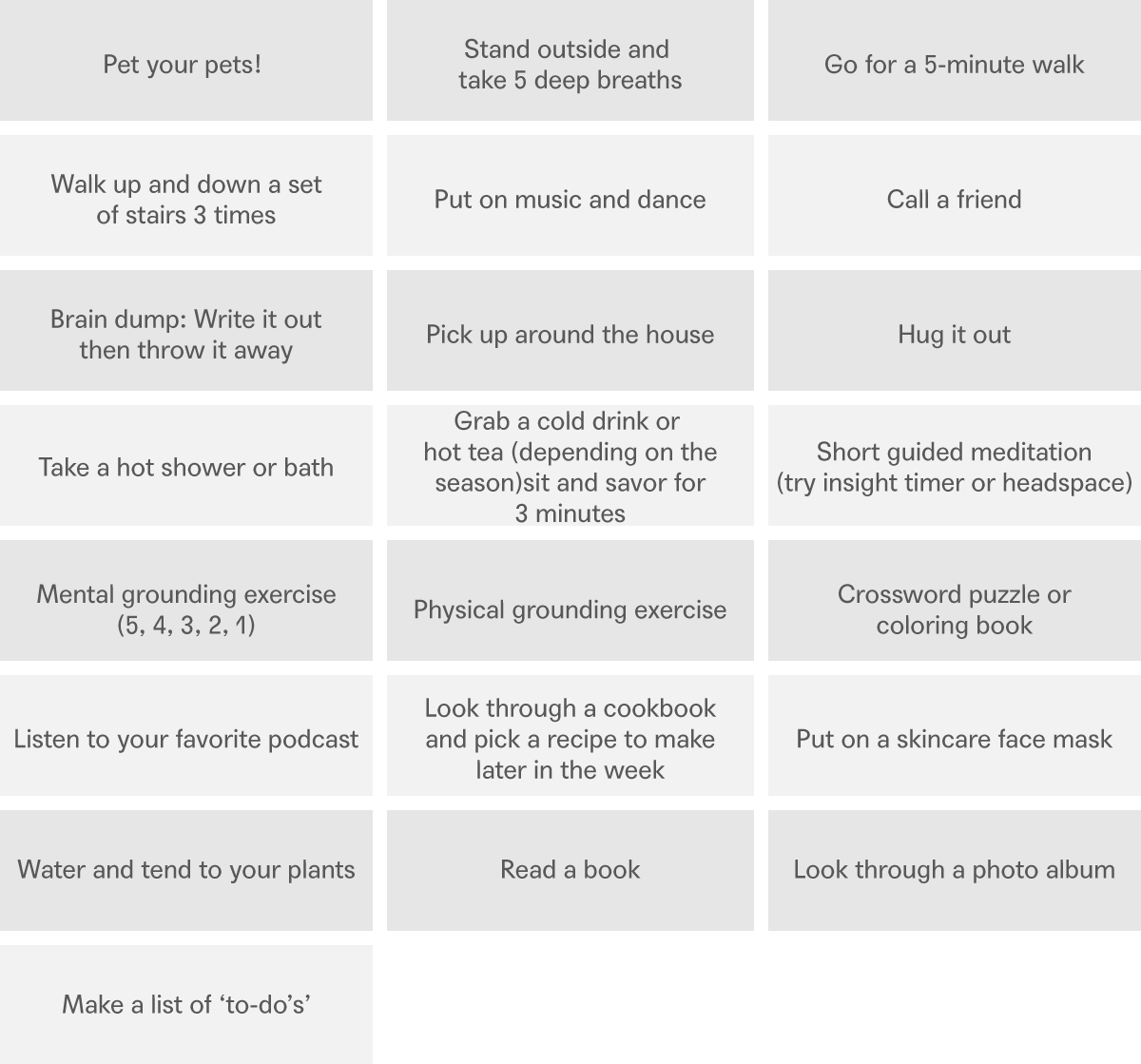
Boundary Setting Conversation
Exploring Your Relationship with Nature
Recent studies demonstrate that being in nature is correlated with greater mental and physical health. It can be a challenge when you live in the city and have a busy life. But you can make just a few small changes that can have a big impact. Consider incorporating small aspects of nature into different areas of your home. For example, if you enjoy the beach, you can place a small tray of sand with a few shells near your desk. Or, try placing a beautiful photograph of the ocean nearby so your eyes have a chance to rest on the peaceful scene when you take a mini break. You can even try playing some beach sounds in a brief listening meditation. Experiment with what might work best for you! And when life feels too busy to take breaks, remember that giving yourself a few minutes to enjoy something you love can actually help you be more productive.
 When thinking about your relationship/exposure to nature, consider the quality of the time you’re spending, not just the quantity. For example, if you are getting out into nature, but are looking at your phone most of the time, the benefits will likely be more limited.
When thinking about your relationship/exposure to nature, consider the quality of the time you’re spending, not just the quantity. For example, if you are getting out into nature, but are looking at your phone most of the time, the benefits will likely be more limited.
Here are a few questions to help inspire you to get creative, get outside, and discover how you feel in nature:
- What kind of interactions did you have with nature as a child?
- How did you play or not play outdoors?
- What thoughts and feelings did you have about nature as a child?
- How much or how little did your caregivers engage with you in outdoor activities?
- What, if any, value does nature have to you?
- How much time do you currently spend outdoors each week?
- Is this amount of time acceptable to you? Does it meet your needs? If not, what prevents you from having more time?
- When you spend time in nature, do you feel any different? What is your response when you’re in a place where you can’t use your cell phone?
How to Talk About Stress
 Managing the demands of modern life can feel overwhelming! It’s easy to neglect our relationships when we’re busy, but that’s when we need people the most. Having a stress-reducing conversation with a loved one or a partner is a great way to give and receive support through tough times. It helps us feel loved, cared for, and valued which promotes a healthy and positive relationship.
Managing the demands of modern life can feel overwhelming! It’s easy to neglect our relationships when we’re busy, but that’s when we need people the most. Having a stress-reducing conversation with a loved one or a partner is a great way to give and receive support through tough times. It helps us feel loved, cared for, and valued which promotes a healthy and positive relationship.
This kind of conversation doesn’t have to last for hours, it can be as simple as setting aside just 30 minutes a day to really tune in and be present with our loved one.
An effective stress-reducing conversation involves:
- Sharing roles equally
- Listener role (quiet, attentive, curious, holds space)
- Speaker role (open, honors self, takes space)
- Taking turns to share about an “outside the relationship stressor”
- Taking your time when it’s your turn to speak (not rushing through)
- Asking questions when you’re the listener
- Checking in before offering your opinion or solutions
- Trying to understand the other person’s perspective more deeply
- Creating a calm atmosphere
- Giving your full attention
- Providing encouragement
- Adopting a “We’re in it together” attitude
Structure of the conversation
Plan ahead. You will want to enjoy time that is completely uninterrupted. Try to get other people and tasks handled before your conversation so you can focus.
Decide who will have what role first; you will take turns being the speaker and the listener for about 15 minutes each. It’s important for each of you to feel heard. (If you are not used to doing this in such a prescribed sort of way, just be patient—it will get easier over time!)
Listener:
- Listen with a supportive ear, hearing them out before thinking about how to respond or what you’ll say when it’s your turn to speak
- Encourage and show the speaker that you can see where they are coming from
- Make eye contact
- Just listen—don’t interrupt and don’t jump in with solutions
- Ask questions like:
- Is there anything I can do to help right now?
- What do you think would help the situation?
- How do you plan to deal with this issue?
- How can I support you through this?
Speaker:
- Really take the time that is being given to you
- Share from the heart about what’s really been causing you stress
- Go into detail on your issue
And again…don’t rush. Just take your time.
At the end of your exchange, notice how you feel. Were you able to focus in and listen? Do you feel heard?
Practicing this type of open conversation allows you to build more positive interactions. If you can have these kinds of supportive talks a few times a week, it will reduce stress and help you strengthen your relationships.
Emotional Mastery: Introduction
Emotional Mastery: Anger
Emotional Mastery: Happiness
Emotional Mastery: Worry
Emotional Mastery: Grief
Emotional Mastery: Fear
Emotional Mastery
Relationship to Anger Conversation
Mental Health Myths: Asking For Help is Weak
Mental Health Myths: I Will Be Forced To Take Medication
Mental Health Myths: Therapy Will Make All My Bad Feelings And Thoughts Go Away For Good
Mental Health Myths: Therapy Is For Crazy People
Mental Health Myths: I’m Going To Lay On A Couch And Talk About My Childhood
Mental Health Myths: A Therapist Can’t Tell Me Anything I Don’t know
Are you having difficulty managing stress on your own? A lot of our members feel the same way. We are trained to help.
“Start a Conversation” with a Crossover a mental health therapist or health coach today.
And as always, if you have other health concerns or questions, reach out to the Crossover physician on your care team.




